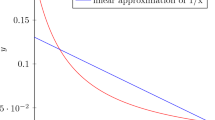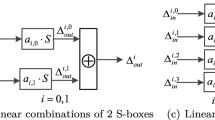Abstract
Differential power analysis is a powerful cryptanalytic technique that exploits information leaking from physical implementations of cryptographic algorithms. During the two last decades, numerous variations of the original principle have been published. In particular, the univariate case, where a single instantaneous leakage is exploited, has attracted much research effort. In this paper, we argue that several univariate attacks among the most frequently used by the community are not only asymptotically equivalent, but can also be rewritten one in function of the other, only by changing the leakage model used by the adversary. In particular, we prove that most univariate attacks proposed in the literature can be expressed as correlation power analyses with different leakage models. This result emphasizes the major role plays by the model choice on the attack efficiency. In a second point of this paper, we hence also discuss and evaluate side channel attacks that involve no leakage model but rely on some general assumptions about the leakage. Our experiments show that such attacks, named robust, are a valuable alternative to the univariate differential power analyses. They only loose bit of efficiency in case a perfect model is available to the adversary, and gain a lot in case such information is not available.
Similar content being viewed by others
References
Kocher P., Jaffe J., Jun B.: Differential power analysis. In: Wiener, M. (eds) Advances in Cryptology—CRYPTO ’99. Lecture Notes in Computer Science, vol. 1666, pp. 388–397. Springer, Berlin (1999)
Messerges T.: Using second-order power analysis to attack DPA resistant software. In: Koç, Ç., Paar, C. (eds) Cryptographic Hardware and Embedded Systems—CHES 2000. Lecture Notes in Computer Science, vol. 1965., pp. 238–251. Springer, Berlin (2000)
Brier E., Clavier C., Olivier F.: Correlation power analysis with a leakage model. In: Joye, M., Quisquater, J.J. (eds) Cryptographic Hardware and Embedded Systems—CHES 2004 Lecture Notes in Computer Science, vol 3156., pp. 16–29. Springer, Berlin (2004)
Le T.H., Clédière J., Canovas C., Robisson B., Servière C., Lacoume J.L.: A proposition for correlation power analysis enhancement. In: Goubin, L., Matsui, M. (eds) Cryptographic Hardware and Embedded Systems—CHES 2006. Lecture Notes in Computer Science, vol. 4249, pp. 174–186. Springer, Berlin (2006)
Bévan R., Knudsen E.: Ways to enhance power analysis. In: Lee, P., Lim, C. (eds) Information Security and Cryptology—ICISC 2002. Lecture Notes in Computer Science, vol. 2587, pp. 327–342. Springer, Berlin (2002)
Mangard, S., Oswald, E., Standaert, F.X.: One for All—All for One: Unifying Standard DPA Attacks. Cryptology ePrint Archive, Report 2009/449 (2009). http://eprint.iacr.org/, to appear in IET Information Security
Schindler W., Lemke K., Paar C.: A stochastic model for differential side channel cryptanalysis. In: Rao, J., Sunar, B. (eds) Cryptographic hardware and embedded systems—CHES 2005. Lecture Notes in Computer Science, vol 3659., Springer, Berlin (2005)
Messerges, T.: Power analysis attacks and countermeasures for cryptographic algorithms. PhD thesis, University of Illinois (2000)
Brier, E., Clavier, C., Olivier, F.: Optimal statistical power analysis. Cryptology ePrint Archive, Report 2003/152 (2003)
Coron, J.S., Giraud, C., Prouff, E., Rivain, M.: Attack and improvement of a secure s-box calculation based on the Fourier transform. [23] 1–14
Golić J., Tymen C.: Multiplicative masking and power analysis of AES. In: Kaliski, B., Koç, Ç., Paar, C. (eds) Cryptographic Hardware and Embedded Systems—CHES 2002. Lecture Notes in Computer Science, vol. 2523, pp. 198–212. Springer, Berlin (2002)
Standaert F.X., Gierlichs B., Verbauwhede I.: Partition vs. comparison side-channel distinguishers: an empirical evaluation of statistical tests for univariate side-channel attacks against two unprotected CMOS devices. In: Lee, P.J., Cheon, J.H. (eds) Information Security and Cryptology—ICISC 2008 Lecture Notes in Computer Science, vol 5461., pp. 253–267. Springer, Berlin (2008)
Prouff E., Rivain M., Bévan R.: Statistical analysis of second order differential power analysis. IEEE Trans. Comput. 58(6), 799–811 (2009)
Mangard S., Oswald E., Popp T.: Power Analysis Attacks—Revealing the Secrets of Smartcards. Springer, Berlin (2007)
Lemke-Rust, K.: Models and algorithms for physical cryptanalysis. PhD thesis, Ruhr-Universität-Bochum, Germany (2007)
Renauld, M., Standaert, F.X., Veyrat-Charvillon, N., Kamel, D., Flandre, D.: A Formal Study of Power Variability Issues and Side-Channel Attacks for Nanoscale Devices. Advances in Cryptology—EUROCRYPT 2011 (2011)
Duan C., Calle V.H.C., Khatri S.P.: Efficient on-chip crosstalk avoidance CODEC design. IEEE Trans. VLSI Syst. 17(4), 551–560 (2009)
Moll F., Roca M., Isern E.: Analysis of dissipation energy of switching digital CMOS gates with coupled outputs. Microelectr. J. 34(9), 833–842 (2003)
Agrawal D., Rao J., Rohatgi P.: Multi-channel attacks. In: Walter, C., Koç, Ç., Paar, C. (eds) Cryptographic Hardware and Embedded Systems—CHES 2003. Lecture Notes in Computer Science, vol 2779, pp. 2–16. Springer, Berlin (2003)
Bishop C.M.: Pattern Recognition and Machine Learning (Information Science and Statistics), 1 edn. Springer, Berlin (2007)
Mangard S.: Hardware countermeasures against DPA—a statistical analysis of their effectiveness. In: Okamoto, T. (eds) Topics in Cryptology—CT-RSA 2004. Lecture Notes in Computer Science, vol. 2964, pp. 222–235. Springer, Berlin (2004)
Standaert, F.X., Archambeau, C.: Using Subspace-Based Template Attacks to Compare and Combine Power and Electromagnetic Information Leakages, [23] pp. 411–425
Oswald, E., Rohatgi, P. (eds.) Cryptographic Hardware and Embedded Systems—CHES 2008. In: Oswald, E., Rohatgi, P. (eds.) Proceedings of 10th International Workshop, Washington, DC, USA, August 10–13, 2008. Lecture Notes in Computer Science, vol. 5154. Springer, Berlin (2008)
Author information
Authors and Affiliations
Corresponding author
Additional information
Research associate of the Belgian Fund for Scientific Research (FNRS—F.R.S.).
Rights and permissions
About this article
Cite this article
Doget, J., Prouff, E., Rivain, M. et al. Univariate side channel attacks and leakage modeling. J Cryptogr Eng 1, 123–144 (2011). https://doi.org/10.1007/s13389-011-0010-2
Received:
Accepted:
Published:
Issue Date:
DOI: https://doi.org/10.1007/s13389-011-0010-2




